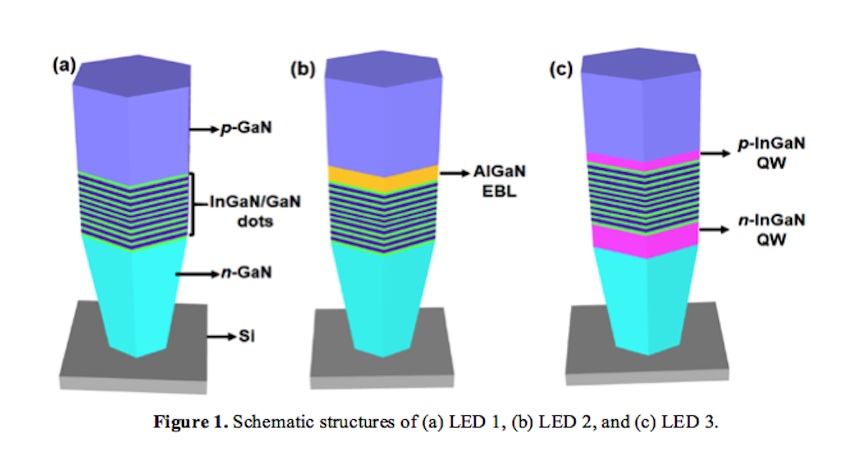Researchers make Electron Blocking Layer-Free Nanowire LEDs

Nanowire full-colour and white LEDs exhibit high internal quantum efficiency of ~ 58.5 percent with stable phosphor-free white-light emission
Researchers from the New Jersey Institute of Technology (NJIT) have demonstrated high efficiency, full-colour and truly white LEDs using an 'electron blocking layer-free' InGaN/GaN nanowire structure using two additional InGaN quantum wells. They published the results in Optics Express in January 2020.
The conventional approach is to use an AlGaN EBL between the device's active region and p-GaN. But this can adversely affect the hole injection process by forming a high barrier. The proposed coupled quantum well approach solves the problem by reducing the electron overflow (the primary source for efficiency degradation).
For the study, the team considered three different InGaN/GaN nanowire LED structures, illustrated in figure 1 above. LED 3 (on the right) is the proposed double quantum well solution. There is an InGaN well between the n-GaN and the active region to control electron overflow. Then in order to use the electrons escaped from the active region, a second InGaN quantum well sits between the active region and p-GaN. This second quantum well reduces electron loss to the p-GaN and contributes blue light emission to relatively control the white light emission from the LED device.
The resulting EBL-free nanowire full-colour and white-colour LEDs exhibited high internal quantum efficiency of ~ 58.5 percent with remarkably stable phosphor-free white-light emission and virtually no efficiency droop, according to the team led by Hieu Pham Trung Nguyen of NJIT’s Department of Electrical and Computer Engineering.
The team has grown InGaN/GaN nanowires on Si (111) substrates by RF plasma-assisted MBE (Veeco Gen II MBE) under nitrogen-rich condition and fabricated devices for characterisation. They say that the resulting structure exhibits excellent current-voltage characteristics with very small leakage current, a high output power and increased external quantum efficiency (EQE) as compared to conventional structure.
In future, the researchers will work on the integration of the coupled quantum wells in the InGaN/AlGaN core-shell nanowire LEDs to improve the uniformity of carrier distribution, and to enhance the radiative recombination in the active region. This will enable high EQE and light output power of the core-shell LED devices, they believe. They hope that such nanowire LEDs will be used in future generations of microLED displays.
'High performance electron blocking layer-free InGaN/GaN nanowire white-light-emitting diodes' by Barsha Jain et al; Optics Express 28, no. 1 (2020)


































